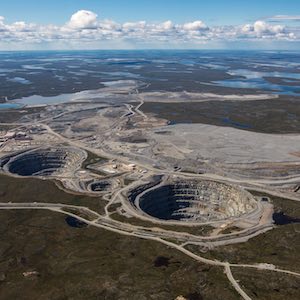
What do you do when you have $180 million in diamonds and can’t sell them?
That’s the problem facing Dominion Diamond Mines, according to an affidavit from Kristal Kaye, its chief financial officer. The company—which owns the Northwest Territories, Canada–based Ekati mine, as well as 40% of nearby Diavik—filed a petition for insolvency protection on Wednesday.
Dominion is currently sitting on stones with a “book value” of $180 million, Kaye said. But with the Indian and Belgian markets closed—and India considering a month-long rough import ban—that big pile of gems is gathering dust. Of course, book value is not an absolute concept. Even when markets open up, “the prices which Dominion Belgium is able to achieve in its diamond sales may be below what has previously been anticipated, or may not be sufficiently economic to merit sales for some period of time,” Kaye admitted.
Plus, like so many businesses that have been put on hold, Dominion still has to pay its bills. On March 19, it put Ekati on care and maintenance, leading to a 400-person reduction in its workforce. But even care and maintenance incurs “material costs,” Kaye said.
Diavik, however, is still running. On Wednesday, Dominion missed a regularly scheduled CAD 16 million payment to fund mine operations, breaching its agreement with joint-venture partner Rio Tinto.
Dominion also has a $20 million interest payment due May 1. It can’t make that, either, Kaye said.
Even though Dominion now faces a “liquidity crisis,” Kaye argued it still owns valuable assets—in 2019, a terrible year for the diamond business, it generated $528 million in sales and $151 million in EBITDA. Yet for all this, there’s a larger issue, which some think made this filing inevitable: Dominion has loads of debt.
In 2017, Washington Companies bought the company for $14.25 a share, or $1.2 billion. But as with Neiman Marcus, that purchase came with a price. Dominion was suddenly saddled with $550 million in secured debt, due November 2022. Dominion’s bonds have been repeatedly downgraded by ratings agencies such as Fitch, which noted on April 10 that the miner has had to “negotiate covenant relief for the past three consecutive quarters.”
Some have long considered the Jay pipe, part of the Ekati deposit, a possible savior. Dominion has touted Jay as “the largest diamondiferous resource in North America.… The open pit portion of the Jay Pipe has the potential to extend the operating life of the Ekati Diamond Mine by a further 10 years…with the potential for an underground mine beyond that.” It once aimed to start mining the Jay pipe by 2021.
But as S&P Global noted in November, it’s “highly capital-intensive” to build a diamond mine. It also takes years. In May 2018, after it was bought by Washington, Dominion announced that it had suspended work on the project. Yet, with production due to fall at both Ekati and Diavik, it must do something if it plans to stick around long-term.
If Dominion closed, it could have a potentially devastating effect on the Northwest Territories economy; 35% of that area’s GDP comes from diamond mining. Fortunately, Washington wants to keep the company alive. It’s submitted a stalking-horse bid that would restructure its debt. That could mean bondholders would take a hit, but they may be amenable: Its bonds are now trading at half their value.
It’s also open to another party buying, or investing in, the miner. But in this environment, as we face another hard year for the gem biz, attracting a suitor may not be any easier than selling $180 million in diamonds.
Top: Aerial view of the Ekati diamond mine (image courtesy of Dominion Diamond Mines)
Follow JCK on Instagram: @jckmagazineFollow JCK on Twitter: @jckmagazine
Follow JCK on Facebook: @jckmagazine